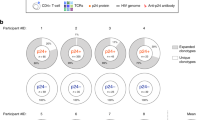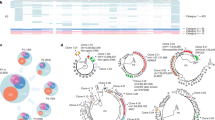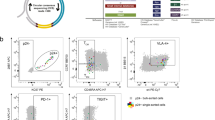Abstract
Replication-competent HIV-1 can be isolated from infected patients despite prolonged plasma virus suppression by anti-retroviral treatment1,2,3. Recent studies have identified resting, memory CD4+ T lymphocytes as a long-lived latent reservoir of HIV-1 (refs. 4,5). Cross-sectional analyses indicate that the reservoir is rather small, between 103 and 107 cells per patient5,6. In individuals whose plasma viremia levels are well suppressed by anti-retroviral therapy, peripheral blood mononuclear cells containing replication-competent HIV-1 were found to decay with a mean half-life of approximately 6 months7, close to the decay characteristics of memory lymphocytes in humans and monkeys8,9,10. In contrast, little decay was found in a less-selective patient population11. We undertook this study to address this apparent discrepancy. Using a quantitative micro-culture assay, we demonstrate here that the latent reservoir decays with a mean half-life of 6.3 months in patients who consistently maintain plasma HIV-1 RNA levels of fewer than 50 copies/ml. Slower decay rates occur in individuals who experience intermittent episodes of plasma viremia. Our findings indicate that the persistence of the latent reservoir of HIV-1 despite prolonged treatment is due not only to its slow intrinsic decay characteristics but also to the inability of current drug regimens to completely block HIV-1 replication.
This is a preview of subscription content, access via your institution
Access options
Subscribe to this journal
Receive 12 print issues and online access
$209.00 per year
only $17.42 per issue
Buy this article
- Purchase on SpringerLink
- Instant access to full article PDF
Prices may be subject to local taxes which are calculated during checkout


Similar content being viewed by others
References
Finzi, D. et al. Identification of a reservoir for HIV-1 in patients on highly active antiretroviral therapy. Science 278, 1295–1300 (1997).
Wong, J.K. et al. Recovery of replication-competent HIV despite prolonged suppression of plasma viremia. Science 278, 1291– 1295 (1997).
Chun, T-W. et al. Presence of an inducible HIV-1 latent reservoir during highly active antiretroviral therapy. Proc. Natl. Acad. Sci. USA 94, 13193–13197 (1997).
Chun, T-W. et al. In vivo fate of HIV-1 infected cells: quantitative analysis of the transition to stable latency. Nature Med. 1, 1284–1290 (1995).
Chun, T-W. et al. Quantification of latent tissue reservoirs and total body viral load in HIV-1 infection. Nature 387, 183 –188 (1997).
Ho, D.D. Toward HIV eradication or remission: the tasks ahead. Science 280, 1866–1867 (1998).
Zhang, L. et al. Quantifying residual HIV-1 replication in patients receiving combination antiretroviral therapy. N. Engl. J. Med. 340, 1605–1613 (1999).
Michie, C.A., McLean, A., Alcock, B. & Beverley, P.C. Lifespan of human lymphocyte subsets defined by CD45 isoforms. Nature 360, 264–265 (1992).
Hellerstein, M. et al. Directly measured kinetics of circulating T lymphocytes in normal and HIV-1-infected humans. Nature Med. 5, 83–89 (1999).
Mohri, H., Bonhoeffer, S., Monard, S., Perelson, A.S., Ho, D.D. Rapid turnover of T lymphocytes in SIV-infected rhesus macaques. Science 279, 1223–1227 (1998).
Finzi, D. et al. Latent infection of CD4+ T cells provides a mechanism for lifelong persistence of HIV-1, even in patients on effective combination therapy. Nature Med. 5, 512–517 ( 1999).
Macken, C.A. Design and analysis of serial limiting dilution assays with small sample sizes . J. Immunol. Meth. 222, 13– 29 (1999).
Perelson, A.S., Neumann, A.U., Markowitz, M., Leonard, J.M., Ho, D.D. HIV-1 dynamics in vivo: virion clearance rate, infected cell life-span and viral generation time. Science 271, 1582–1586 ( 1996).
Wei, X. et al. Viral dynamics in human immunodeficiency virus type 1 infection . Nature 373, 117–122 (1995).
Ho, D.D. et al. Rapid turnover of plasma virions and CD4 lymphocytes in HIV-1 infection. Nature 373, 123– 126 (1995).
Perelson, A.S. et al. Decay characteristics of HIV-1 infected compartments during combination therapy. Nature 387, 188– 191 (1997).
Furtado, M.R. et al. Persistence of HIV-1 transcription in peripheral blood mononuclear cells in patients receiving potent antiretroviral therapy. N. Engl. J. Med. 340, 1614–1622 ( 1999).
Natarajan, V. et al. HIV-1 replication in patients with undetectable plasma virus receiving HAART. Lancet 353, 119– 120 (1999).
Lewin, S.R. et al. The use of real-time PCR and molecular beacons to detect virus replication in HIV-1 infected individuals on prolonged effective antiretroviral therapy. J. Virol. 73, 6099– 6103 (1999).
Gunthard, H.F. et al. Higher selection pressure from antiretroviral drugs in vivo results in increased evolutionary distance in HIV-1 pol. Virology 259, 154–165 ( 1999).
Altice, F.L. & Friedland, G.H. The era of adherence to HIV therapy. Ann. Intern. Med. 129, 503– 505 (1998).
Lucas, G.M., Chaisson, R.E. & Moore, R.D. Highly active antiretroviral therapy in a large urban clinic: risk factors for virologic failure and adverse drug reactions. Ann. Intern. Med. 131, 81–87 (1999).
Palella, F.J. et al. Declining morbidity and mortality among patients with advanced human immunodeficiency. N. Engl. J. Med. 338, 853–860 (1998).
Ortiz, G.M. et al. HIV-1-specific immune responses in subjects who temporarily contain virus replication after discontinuation of HAART. J. Clin. Invest. 104, –R13–R18 (1999).
Chun, T-W. et al. Effect of interleukin-2 on the pool of latently infected, resting CD4+ T cells in HIV-1-infected patients receiving highly active anti-retroviral therapy. Nature Med. 5, 651–655 (1999).
Acknowledgements
We thank L. Krikoun for technical assistance, E. Jones for help with data collection and W. Chen for preparation of the figures. This work was supported by National Institutes of Health grants AI40387, RR06555 and AI41534, the Columbia–Rockefeller Center for AIDS Reseach (AI42848), the General Clinical Research Center of The Rockefeller University (MO1-RR00102), The Belotsky Foundation, The Irene Diamond Fund and the Bristol Myers Squibb Foundation. B.R. is supported by the Rockefeller University Clinical Scholar's Program.
Author information
Authors and Affiliations
Corresponding author
Rights and permissions
About this article
Cite this article
Ramratnam, B., Mittler, J., Zhang, L. et al. The decay of the latent reservoir of replication-competent HIV-1 is inversely correlated with the extent of residual viral replication during prolonged anti-retroviral therapy. Nat Med 6, 82–85 (2000). https://doi.org/10.1038/71577
Issue Date:
DOI: https://doi.org/10.1038/71577



